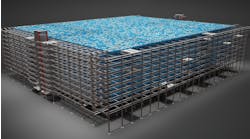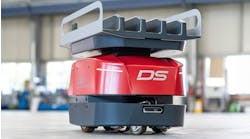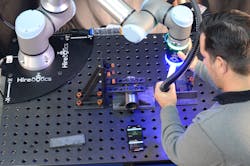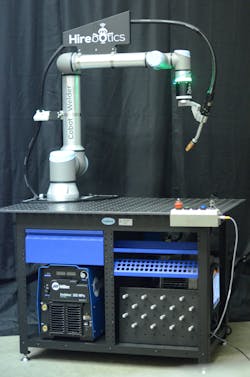There is no looming shortage of skilled welders. It’s here. Now. Manufacturers across the globe are struggling to find and retain skilled welders to meet their current production demands, much less consider how to staff up to grow their business.
Thankfully, a new breed of welding robot that combines collaborative robot (or ‘cobot’) technology, welding hardware, and easy-to-use programming software is helping small and medium-sized businesses overcome these long-standing labor challenges.
Cobot-based welding automation delivers all the benefits of traditional automation, including improved quality and increased throughput and production. The similarities with traditional automation end there, however, because cobot-based welding springs from a fresh approach to robotics and to the relation between human labor and automation.
The result is enhanced welding cell performance with improved throughput, productivity, ergonomics, and weld quality—all at a fraction of the cost of traditional robot welding systems.
Why Welding Robots?
Back in 1999, the American Welding Society published a survey of members about the shortage of skilled welders. The survey indicated that 72% considered the situation problematic “now and for the long term, 14% did not see a shortage, and the remaining 14% either see no shortage now, but expect one in the future or see a shortage for 1999, but not for the future.”
Fast forward to today and manufacturing executives surveyed as part of Deloitte’s 2021 Manufacturing Talent study report that finding the right manufacturing talent is now 36% harder than it was in 2018 and 77% expect to have ongoing difficulties in attracting and retaining workers in 2021 and beyond. Misconceptions about the ability of manufacturing jobs to provide quality career experiences and work-life balance were a significant disincentive—particularly for younger workers—the study found, and some 500,000 manufacturing jobs remain unfilled in the United States alone.
Experts have been proposing the same solution to this problem since 1999—investment in vocational educational programs and robotic welding systems—without changing the trend.
And unfortunately, traditional approaches to welding automation have left small to medium-sized businesses—and welders—out in the cold.
Traditional Welding Robots
Originally developed for the automotive and heavy equipment industries, robot welding is used to automate high volume, highly repetitive, and dangerous welding processes.
Even today, traditional welding robots are held in large safety cages, require experts to program, and are best suited to low mix/high volume production. Both the robots themselves and the tooling they require are extremely expensive, which has made welding automation unaffordable for most small-to-medium size companies.
As the robotic welding industry matured, success was measured in cycle times and deposition rates, leading to the development of technologies such as Through Arc Seam Tracking. A small, highly specialized group of robot welding experts possessed the knowledge and skills to make deployments work. And, with every ‘advance’ in specialized software counterintuitively making welding robots even more complex to operate, people with the required robot programming skillsets have remained difficult to find and costly to hire.
Crucially, traditional welding robot systems were developed to replace human welders entirely, not to enhance the welding experience.
So, traditional automation paradigms address the needs of large industries with low mix/high volume production, plenty of floor space, and deep pockets. Job shops and smaller manufacturers, especially those handling high mix/low volume production, were simply not part of the conversation—and welders were effectively written out of the equation.
The Cobot Paradigm
These traditional paradigms have been completely transformed by the emergence of cobot-based welding automation. First, cobot-based welding robots are available at a fraction of the cost of traditional welding robots, which ensures a faster Return on Investment (ROI) and lower Total Cost of Ownership (TOC). The affordable price point of cobot-based welding robots has enabled numerous small to medium-sized companies to enjoy the benefits of welding automation for the first time.
Additionally, following a risk assessment, it is possible to deploy cobot-based welding automation without special fencing, which saves on precious floor space—often a key factor for small job shops. While traditional welding robots have a large footprint and are difficult to move around, cobot-based systems are highly mobile and easy to transport via hand cart or trolley.
Crucially, cobot-based welding robots are designed to augment and enhance the welder’s experience. Instead of replacing human labor entirely, cobot-based welding robots work with human welders. The cobot takes care of unergonomic and repetitive tasks (such as welds that involve a lot of bead laying), while skilled human welders focus on more strategic, higher-value activities.
Ideally, cobot-based welding automation combines the best of human and robot skillsets in an easy-to-use system that enables manufacturers to enhance their existing workforce and address labor availability challenges.
The emergence of cobots over the past decade has transformed traditional automation paradigms, but cobots are not complete systems in themselves. They require additional end-of-arm tooling and software to take on specific applications, including, of course, welding—and here is where the differences between the various cobot-based welding robots become apparent.
Choosing a Cobot Welder
Usability is critical to the success of cobot-based welding deployments. Some systems require extensive training to operate, which increases costs and delays deployments. By contrast, systems such as Hirebotics’ Cobot Welder, for example, provide an intuitive programming process that is designed for welders, not for robot programmers.
Programming the system is as simple as guiding the welding torch into place by moving your cobot’s arm around by hand and then confirming these positions by pressing a button in the provided Beacon application, which runs on any smartphone, tablet, or web browser.
The most significant advancement of this new interface is that it is already familiar to your welders. Nearly everyone has a smartphone with a variety of apps. User experience patterns in mobile apps are intuitive and familiar, such as swiping or drag-and-drop. Conversely, robot teach pendants—even cobot teach pendants—have a myriad of menus and submenus because they are designed for robot programmers to apply a variety of applications instead of a complete experience designed for arc welding.
This simple, intuitive programming process, which welders can pick up in a matter of minutes regardless of their previous exposure to robotics, means faster and more cost-effective deployments. In this way, Cobot Welder quickly turns welders into welding robot operators.
Software can play a key role beyond enhancing usability, so make sure to look for extra functionality to support your welding operations. For example, Cobot Welder comes with Beacon software, which enables easy programming, but also provides remote access and maintenance functionality (including reporting consumables usage), as well as the ability to select from cloud-based weld libraries.
Look out for systems that provide all you need to get started on your welding application with a minimum of fuss. This includes compatible welding hardware, a worktable, and software to tie it all together. Incomplete systems or systems with poor supporting software will add to the cost and complexity of your welding robot deployment.
Cobots differ in terms of payload, functionality, and performance, so be sure to select a system that uses trusted and proven cobot hardware that can meet your welding application requirements. And remember that there is still a place for traditional welding robots, especially for high-speed, large batch production.
The Future of Welding
Cobot-based welding systems are the product of new, human-centered, automation paradigms that incorporate millennial-friendly programming tools, augment human productivity, and improve ergonomics for workers.
Can systems like Cobot Welder help change young people’s perception of careers in the manufacturing sector as being old-fashioned and unrewarding? That remains to be seen, but the prospect of working with a snazzy-looking welding robot that handles the dull, dirty, and dangerous elements of welding is surely a more attractive proposition than the traditional welder’s job description.
To find out more about cobot-based welding and how you can turn your welders into robot programmers, visit: https://www.hirebotics.com/
Rob Goldiez is the CEO and co-founder of Hirebotics.













